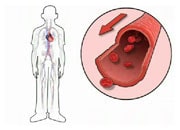How does the normal heart work? Part 2
Your heart is made up of four chambers, two chambers on the right side and two on the left. The walls of these chambers are made of special heart muscle. The small chambers at the top of your heart are called atria and the large chambers below are called ventricles. Each ventricle has one valve at its entrance and one at its exit to prevent blood from flowing backwards through the heart.
Your atria and ventricles work together by alternately contracting (systole or systolic phase), to push blood out of the heart, and relaxing (diastole or diastolic phase), to fill with blood. At the start of each heartbeat a tiny electrical signal near the top of the heart spreads through your heart muscle making it contract. The atria contract first, pushing blood through the open valve into the ventricle. The electrical impulse then travels into the muscle of the ventricle, making it contract and push blood out of your heart to your lungs and body. As the ventricles contract the atria relax, allowing them to fill with blood and start the next beat.




















